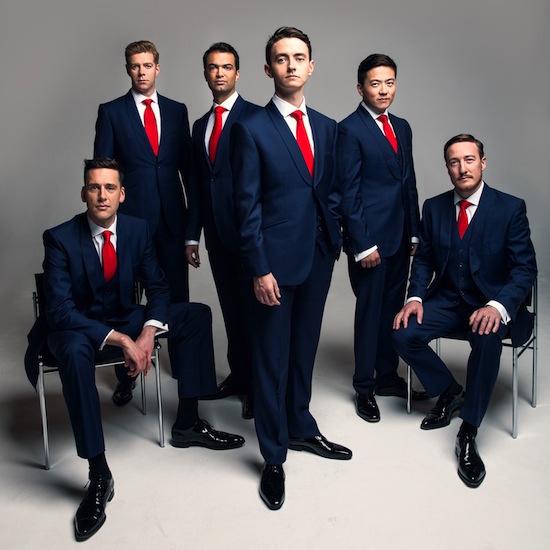A new generation for the King’s Singers but with the same polished artistry
Nearly fifty years ago, a group of young choral scholars at King’s College, Cambridge formed a vocal ensemble aimed at performing music in a wide variety of styles and genres. The King’s Singers, as they became known, made a name for themselves over the intervening decades through performances and recordings that feature a range from classical to folk and pop.
Today, the ensemble is a mix of young musicians. All the original members have long moved on to do other things. But the ensemble’s original mission of presenting vocal works with a characteristic polished and sophisticated tone has remained as strong as ever.
The King’s Singers indeed possess a unique sound. Their vocal blend has the pristine sonority of an English boy choir, and chords seem to resonate from the bottom up, an effect known to King’s Singer aficionados as the pyramid of sound.
That sound was present Monday night at Jordan Hall, where the ensemble offered a program of Renaissance masterworks as part of the Boston Early Music Festival.
The ensemble’s look was just as slick as the performance. The singers were dressed in matching dark suits and red ties, and each sang from scores collected in matching iPads.
Their program combined sacred and secular music by well-known composers such as Orlando di Lasso, Palestrina, Sweelinck, and Josquin des Prez. It was a particular delight to hear Psalm settings by Salamone Rossi, one of the few Jewish composers of the era.
Rossi’s style resembles the glowing harmonic sonorities of Josquin and Palestrina’s music. The Psalm settings heard Monday night, each set in Hebrew, mix passages of thick chords with tightly woven lines. In “Ledavid” the singers’ phrases coalesced into harmonies of warm resonance. The chords of “Ashrei kol yere adonai,” a setting of Psalm 128, flickered like a candle flame, the texture dotted with bristly dissonances.
In the more intricate works the King’s Singers sang with precision and smooth lyrical flow while shading each phrase with tasteful dynamics. The lines of Palestrina’s “Surge propera amica mea” made unexpected harmonic turns, and in “Sicut lilium inter spinas” the individual melodies broke out of the texture like foam on a wave.
Sweelinck never finished his planned set of the complete Psalms in French. But what he did finish reveals music of deep mystery and delicacy. Two of those works heard Monday night, “Ne veuilles pas, ô Sire” and “Mon Dieu j’ay en toy espérance,” flowed in dolorous phrases as the King’s Singers rendered each with pure, elegant tone.
In other works, the ensemble sang with a keen sense of rhythm. In di Lasso’s “Domine Dominus noster” the phrases skipped and frolicked as if in a dance. Those characteristics were particularly poignant in the secular works. Claude Le Jeune’s “Revecy venir du Printans” seemed to twirl about in place. In di Lasso’s madrigal “Chi chilichi?” the singers brought to touch of humor, holding their noses to conjure the nasal sounds of a hurdy gurdy.
Gesualdo’s “Moro lasso,” also heard Monday night, is just as famous as the murders its composer committed. Its texture features jarring harmonic twists that were centuries ahead of their time. The King’s Singers delivered the piece with palpable sadness and tender grace.
Di Lasso’s “Dessus le marché d’Arras,” which closed the program, tells of a Spanish soldier who simply asks a woman “how much?,” and it is not known what he is asking to buy. Before delivering a crisp and energetic reading of the madrigal, one of the King’s Singers joked, “We think we know, but because we’re British, we’d rather not say.”
For encores, the King’s Singers treated listeners to dreamy versions of a Spanish quinta and Hoagy Carmichael’s “Lazybones” and “Lazy River.”
The next concert of the Boston Early Music Festival will feature harpsichordist Béatrice Martin in music of Rameau, Couperin, Scarlatti, Vivaldi, and others 5 p.m. at The Fenway Center. bemf.org
Posted in Performances





